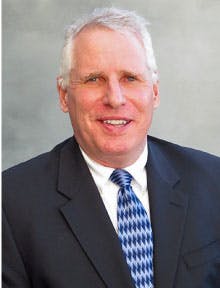While finishing up my research for this month’s cover story, “Why ‘Buy American’ Still Matters,” (p. 16), I saw a news brief on CNN reporting that it only costs Google about $3.50 to $4 more per unit to manufacture its new Moto X smartphone in Texas than it would to do it offshore.
This news brief got me thinking about offshoring in the electrical manufacturing community, and when and if it will ever be cost effective for electrical manufacturers to do more of their manufacturing stateside. I am not a Pollyanna on this issue and realize that when many electrical manufacturers did their cost analyses on keeping their U.S. factories at home years if not decades ago, the answer penciled out much better across the Pacific pond. But as Google found out, these cost analyses sometimes do point to the United States.
Despite this happy news, U.S.-based manufacturing isn’t making any sort of remarkable comeback. In fact, the long-term data from the Bureau of Labor Statistics (BLS) on manufacturing employment is rather disheartening. Its 2013 estimate for about 12 million factory workers is a 31% decline from the 17.6 million workers employed in 2000.
The reasons for this decline are far beyond the scope of this editorial, and the best advice I can offer to industrially oriented companies is that they must make the best of the industrial business they still have. The potential is still sizable, because the industrial market accounts for 26% of all electrical products sold through electrical distributors. The EW Market Planning Guide’s sales multipliers
show that when you size up the sales potential for the industrial facilities in your market, each employee represents $698 in electrical MRO sales and $714 electrical OEM sales.
You might be sick of reading about the sales potential of lighting retrofits and energy audits at industrial facilities, but you can’t deny that they still produce real sales dollars. And that’s a good thing, considering the sluggish recovery of construction market in many regions.
What would it take to create more manufacturing in this country? A July 2009 article in the Harvard Business Review, “Restoring American Competitiveness,” says a disturbing trend in the U.S. manufacturing arena is the erosion of “the industrial commons.” In agricultural societies, “the commons” was an area where all the animals in a community would graze together. No one person owned the land, and all the farmers or ranchers were better off because they could share this public space.
The article explored how some of the most vibrant regional U.S. economies specialized in a particular type of industry and became centers of excellence in that field or technology. They all had an “industrial commons” that attracted workers and researchers with a specific skill set, and everyone benefitted from the exchange of ideas and the availability of jobs in those industries. These areas included Detroit during its heyday as the U.S. auto capital; the semiconductor industry in Silicon Valley; computer software in Seattle; and the biotech within Boston’s Route 128 beltway.
In the electrical market we had centers of industrial control expertise in Milwaukee, and wire and cable manufacturing in New England. These electrical centers of excellence aren’t quite as vibrant now as they once were, due in large part to consolidation, offshoring, and regional economic challenges associated with high taxes and lack of business incentives.
Could our industry once again build these centers of product excellence? It’s already underway in some cutting technologies that could one day offer massive potential. In the LED market, the Department of Energy is as serious as a heart attack about getting more lighting manufacturers to build up their domestic R&D presence, and over the past few years has provided millions of dollars in matching funds through its “Solid-State Lighting Manufacturing Funding Opportunity” program to do just that.
In addition, over the past three years the DOE has funded “Energy Innovation Hubs,” including facilities that focus on advanced battery storage (think electric vehicles and solar or wind farms with massive battery storage), energy-efficient buildings and solar energy.
It makes sense to gather the best minds in select fields to see what they can develop for the good of an industry. Would the concept of an industrial commons still work in the electrical market? There’s only one way to find out.
About the Author
Jim Lucy
Editor-in-Chief of Electrical Wholesaling and Electrical Marketing
Jim Lucy has been wandering through the electrical market for more than 40 years, most of the time as an editor for Electrical Wholesaling and Electrical Marketing newsletter, and as a contributing writer for EC&M magazine During that time he and the editorial team for the publications have won numerous national awards for their coverage of the electrical business. He showed an early interest in electricity, when as a youth he had an idea for a hot dog cooker. Unfortunately, the first crude prototype malfunctioned and the arc nearly blew him out of his parents' basement.
Before becoming an editor for Electrical Wholesaling and Electrical Marketing, he earned a BA degree in journalism and a MA in communications from Glassboro State College, Glassboro, NJ., which is formerly best known as the site of the 1967 summit meeting between President Lyndon Johnson and Russian Premier Aleksei Nikolayevich Kosygin, and now best known as the New Jersey state college that changed its name in 1992 to Rowan University because of a generous $100 million donation by N.J. zillionaire industrialist Henry Rowan. Jim is a Brooklyn-born Jersey Guy happily transplanted with his wife and three sons in the fertile plains of Kansas for the past 30 years.

